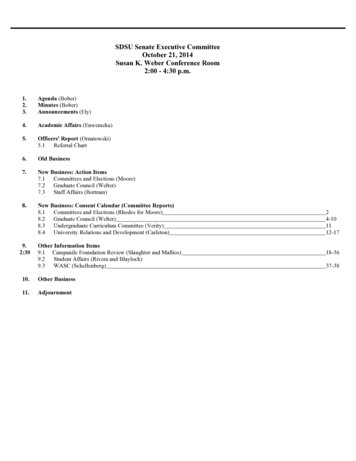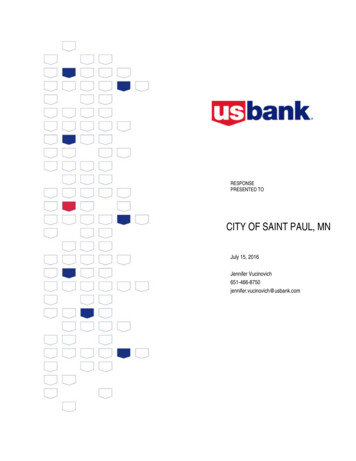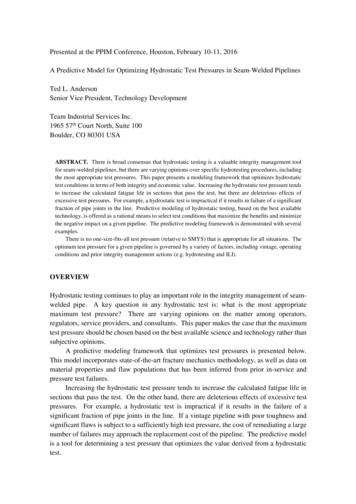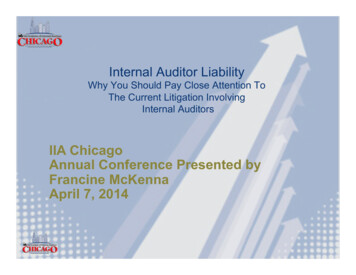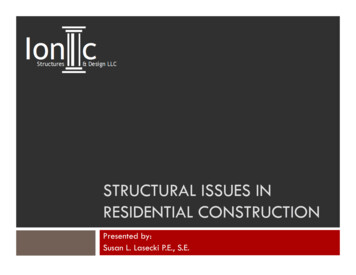
Transcription
STRUCTURAL ISSUES INRESIDENTIAL CONSTRUCTIONPresented by:Susan L. Lasecki P.E., S.E.
Presentation Outline Gravity Design LoadPaths from Roof to Foundation Roof Framing Floor Framing Wall Framing Lateral Loads Basementwalls Wind Loads and Shear walls – Future presentation
Gravity Design Complete load pathsinclude the transfer ofvertical loads (bothdownward and uplift)from the roof to thefoundationsLoad SourcesDead load – selfweight Snow load Live load
Gravity Design - Roof Roof FramingManufactured wood trusses Conventional Framing Joist and rafter tables inAppendix based on spanand species and allowabledeflectionLoadsSnow Wind Downward – does not govern Uplift 20 psf
Conventional Roof Framing Conventional roof framing consists of 2x membersinstalled as roof rafters and ceiling joists. Codesection SPS321.27 Typicalspacing 16” o.c. Roof framing members required to be anchored usingengineered clips, straps or hangers. Collar ties every 48” o.c. Ceiling joists are required for providing lateralrestraint. If ceiling joists are not provided anengineered system needs to be in place such as a ridgebeam, wall ties, etc.
Roof Trusses Pre-manufactured roof framing system typicallyinstalled at @ 24” o.c.Issues: Connections Gableend framing Temporary bracing
Roof Truss - Connections Connections must resist loads from wind shear, winduplift and top of wall wind reaction.
Roof Truss – Gable End FramingGable End Framing Top of wall bracing typically accomplished by attachment of drywall sheathing totruss bottom chord which is then transferred into the perpendicular wallsIllustration fromthe AlpineEncyclopedia ofTrusses
Roof Truss – Gable End FramingGable End Framing When the loads atthe gable end arevery high, anothermethod may beneeded to transferthe wind loads intothe perpendicularwalls. A horizontal truss isused in thisapplicationIllustration from the Commentary forPermanent Bracing of Metal PlateConnected Wood Trusses, John E. Meeks
Roof Truss – Gable End FramingGable End Framing Diagonal bracing used to transfer the wind reaction to the woodroof diaphragmIllustration from the Commentary forPermanent Bracing of Metal PlateConnected Wood Trusses, John E. Meeks
Roof Truss - Bracing Permanent bracing is designed by the truss supplierand illustrated on the truss shop drawings.Temporary bracing is the responsibility of thegeneral contractor in accordance with theinstallation instructions provided by the trusssupplier.(see next slide)
Illustration from theAlpine Encyclopedia ofTrusses
Gravity Design – Floor Joists Floor Framing Manufacturedwood trusses TJI Conventional JoistFramingtables in Appendix basedon span, species andallowable deflection Loads Deadload Live load
Joist CantileversWI - UDC(6) OVERHANG OF FLOORS. (a) General. Except as provided in pars. (b) and (c), a floor joist overhang shall becantilevered beyond the outer edge of the supporting wall below it by no more than the actual depth of the joistor shall be designed through structural analysis in accordance with s. SPS 321.02 (3).(b) Joist overhangs parallel to the main floor framing system. Joist overhangs that are extensions of, and parallelto, the main floor framing system may extend beyond the depth of the joist without structural analysis providedthey meet all of the following conditions:1. The overhang is cantilevered no more than 2 feet beyond the outer edge of the supporting wall below it.2. a. The overhang supports a uniform load limited to the weight of the bearing wall and the tributary roof areaabove it.b. The tributary length of the roof area, excluding the eave overhang, is no more than 2 feet greater than theactual length of the joist directly below.This section continues IRC R502.3.3 Floor cantilevers. Floor cantilever spans shall not exceed the nominal depth of the wood floorjoist. Floor cantilevers constructed in accordance with Table R502.3.3(1) shall be permitted when supportinga light-frame bearing wall and roof only. Floor cantilevers supporting an exterior balcony are permitted tobe constructed in accordance with Table R502.3.3(2).
Joist CantileversIn General Cantilevers must have abackspan to cantilever ratio of2:1 minimum.If the cantilever end is loadedwith a wall, the ratio needs to beincreased.If a cantilever does not fit withinthe “prescriptive” text of thecode, it should be reviewed byan engineer.Solid blocking should be installedbetween all cantilevered joists atthe bearing location.
Floor FramingBridging/Blocking –Conventional wood framing Diagonal Solid
Floor Joists – Parallel to Basement Wall Wisconsin UDC
Load Bearing Wood Studs Capacity of studs is based on: Maxspacing. Assumed loads. Stud grade species Fully braced studs in weak direction. Applicationof sheathing or drywall on one sideor Blocking at 4’-0” o.c. (minimum)
Gravity Design – Wood wallsWisconsin Residential Code Maximum allowable unbraced height for a load bearing wall is 10’-0”without additional engineering
Gravity Design – Wood wallsIRC Maximum allowable unbraced height for a load bearing wall is 10’-0”without additional engineeringa. Listed heights are distancesbetween points of lateral supportplaced perpendicular to the planeof the wall. Increases inunsupported height are permittedwhere justified by analysis.b. Shall not be used in exteriorwalls.c. A habitable attic assemblysupported by 2 4 studs islimited to a roof span of 32 feet.Where the roof span exceeds 32feet, the wall studs shall beincreased to 2 6 or the studsshall be designed in accordancewith accepted engineeringpractice.
Tall Walls
Full HeightBasement Wall LoadsLoads Total horizontal loadW q*h 2/2 q can vary from 40 to65 lbs/ft depending onthe soil conditions(lower for sand andhigher for clay) Top reaction W/3 Bottom reaction 2/3W
Partial HeightFoundation WallsObserved ConditionPotential failure: Rotation of the frost wall inward Excessive rotation could cause afirst floor framing collapseRepair Methods – for existingconditions Install wood or metal studs fullheight inside the wall capable ofsupporting full lateral load.Anchor studs to slab on gradeand wood floor framing above.
Partial Height Foundation WallsCode RequirementsWI-UDC SPS 321.18 Foundations. (1) GENERAL. (a) Design. Foundationwalls shall be designed and constructed to support the verticalloads of the dwelling, lateral soil pressure, and other loadswithout exceeding the allowable stresses of the materials ofwhich the foundations are constructed.(b) Lateral support at base. Lateral support such as floor slabor framing shall be provided at the base of foundation walls.(c) Lateral support at top. Lateral support shall be provided atthe top of the foundation walls by one of the following: 2. Structural analysis. A system designed through structural analysis3. Anchor bolts. a. Structural steel anchor bolts, at least ½inch in diameter,embedded at least 7 inches into the [concrete or] grouted masonry with amaximum spacing of 72 inches and located within 18 inches of wall corners.
Partial Height Foundation WallsCode RequirementsIRCR404.1.2.2.2 Concrete foundation stem walls supporting light-frame above-grade walls.Concrete foundation stem walls that support light-frame above-grade walls shall bedesigned and constructed in accordance with this section. 1. Stem walls not laterallysupported at top. Concrete stem walls that are not monolithic with slabs-on-ground or arenot otherwise laterally supported by slabs-on-ground and retain 48 inches (1219 mm) orless of unbalanced fill, measured from the top of the wall, shall be constructed in accordancewith Section R404.1.2. Foundation stem walls that retain more than 48 inches (1219 mm) ofunbalanced fill, measured from the top of the wall, shall be designed in accordance withSections R404.1.3 and R404.4.R404.1.3 Design required. Concrete or masonry foundation walls shall be designed inaccordance with accepted engineering practice when either of the following conditionsexists: 1. Walls are subject to hydrostatic pressure from groundwater. 2. Walls supportingmore than 48 inches (1219 mm) of unbalanced backfill that do not have permanent lateralsupport at the top or bottom.R404.4 Retaining walls. Retaining walls that are not laterally supported at the top and thatretain in excess of 24 inches (610 mm) of unbalanced fill shall be designed to ensurestability against overturning, sliding, excessive foundation pressure and water uplift.Retaining walls shall be designed for a safety factor of 1.5 against lateral sliding andoverturning.
Partial HeightFoundation WallsCorrect Design Condition Design lower portion of wall asa retaining wall. Wall needs to be connected tofooting with dowels at uniformspacing. Connection between wall andfooting is considered “fixed”rather than hinged.
Foundation Construction:Multiple Top PlateRecently observed conditionin a home where the G.C.wanted to increase clearheight in basement withoutusing taller concrete forms. The triple top plateleads to an indirect loadtransfer and thepotential for the top ofthe wall to rotateinward. The plate toplate connection is not afixed connection and theplates can separate.Not sure how the anchorbolts were installed.
Questions? Also, please feel free to ask questions via phone oremail at: Slasecki@ionic-sd.com 414-540-8755
Roof framing members required to be anchored using engineered clips, straps or hangers. . Floor cantilever spans shall not exceed the nominal depth of the wood floor joist. Floor cantilevers constructed in accordance with Table R502.3.3(1) shall be permitted when supporting a light-frame bearing wall and roof only. Floor cantilevers supporting an exterior balcony are permitted to be .

